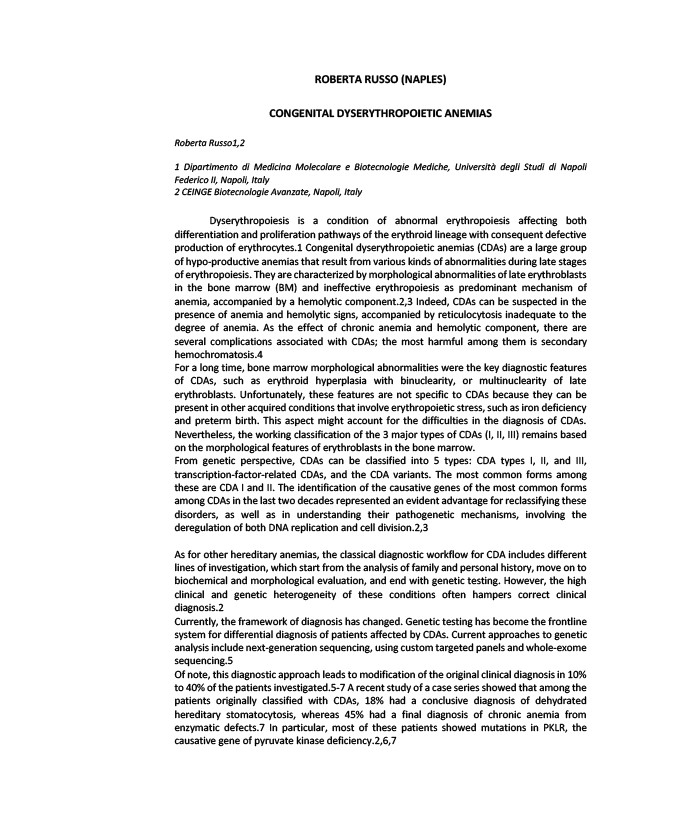
ROBERTA RUSSO (NAPLES)
CONGENITAL DYSERYTHROPOIETIC ANEMIAS
Roberta Russo1,2
1 Dipartimento di Medicina Molecolare e Biotecnologie Mediche, Università degli Studi di Napoli
Federico II, Napoli, Italy
2 CEINGE Biotecnologie Avanzate, Napoli, Italy
Dyserythropoiesis is a condition of abnormal erythropoiesis affecting both
differentiation and proliferation pathways of the erythroid lineage with consequent defective
production of erythrocytes.1 Congenital dyserythropoietic anemias (CDAs) are a large group
of hypo-productive anemias that result from various kinds of abnormalities during late stages
of erythropoiesis. They are characterized by morphological abnormalities of late erythroblasts
in the bone marrow (BM) and ineffective erythropoiesis as predominant mechanism of
anemia, accompanied by a hemolytic component.2,3 Indeed, CDAs can be suspected in the
presence of anemia and hemolytic signs, accompanied by reticulocytosis inadequate to the
degree of anemia. As the effect of chronic anemia and hemolytic component, there are
several complications associated with CDAs; the most harmful among them is secondary
hemochromatosis.4
For a long time, bone marrow morphological abnormalities were the key diagnostic features
of CDAs, such as erythroid hyperplasia with binuclearity, or multinuclearity of late
erythroblasts. Unfortunately, these features are not specific to CDAs because they can be
present in other acquired conditions that involve erythropoietic stress, such as iron deficiency
and preterm birth. This aspect might account for the difficulties in the diagnosis of CDAs.
Nevertheless, the working classification of the 3 major types of CDAs (I, II, III) remains based
on the morphological features of erythroblasts in the bone marrow.
From genetic perspective, CDAs can be classified into 5 types: CDA types I, II, and III,
transcription-factor-related CDAs, and the CDA variants. The most common forms among
these are CDA I and II. The identification of the causative genes of the most common forms
among CDAs in the last two decades represented an evident advantage for reclassifying these
disorders, as well as in understanding their pathogenetic mechanisms, involving the
deregulation of both DNA replication and cell division.2,3
As for other hereditary anemias, the classical diagnostic workflow for CDA includes different
lines of investigation, which start from the analysis of family and personal history, move on to
biochemical and morphological evaluation, and end with genetic testing. However, the high
clinical and genetic heterogeneity of these conditions often hampers correct clinical
diagnosis.2
Currently, the framework of diagnosis has changed. Genetic testing has become the frontline
system for differential diagnosis of patients affected by CDAs. Current approaches to genetic
analysis include next-generation sequencing, using custom targeted panels and whole-exome
sequencing.5
Of note, this diagnostic approach leads to modification of the original clinical diagnosis in 10%
to 40% of the patients investigated.5-7 A recent study of a case series showed that among the
patients originally classified with CDAs, 18% had a conclusive diagnosis of dehydrated
hereditary stomatocytosis, whereas 45% had a final diagnosis of chronic anemia from
enzymatic defects.7 In particular, most of these patients showed mutations in PKLR, the
causative gene of pyruvate kinase deficiency.2,6,7